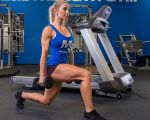Best Gym Workout Plans for Lean Muscle
Building lean muscle is a goal that many fitness enthusiasts aspire to, but it requires the right approach. If you're looking to get stronger, more defined muscles without gaining excess bulk, the key is to focus on workouts that prioritize muscle growth while keeping fat gain at bay. In this article, I will share the best gym workout plans for lean muscle, as well as practical tips for optimizing your training routine. Whether you're a beginner or an experienced lifter, these strategies can help you achieve your fitness goals efficiently.
1. Understanding Lean Muscle Growth
Before diving into specific workout plans, it's important to understand what lean muscle is and how it differs from bulking. Lean muscle refers to the muscle mass that is developed without the accumulation of excess fat. Unlike bulking, which often involves eating in a calorie surplus to gain weight, building lean muscle requires a more balanced approach—focusing on strength training with a moderate calorie surplus while keeping your diet clean.
In my own experience, building lean muscle means focusing on strength and endurance while avoiding excessive calorie intake. This ensures that the muscle I build is solid and defined rather than soft or padded with fat. The key is consistency and a strategic workout plan that incorporates both resistance training and cardiovascular work.
2. Resistance Training for Lean Muscle
Resistance training is essential when it comes to building lean muscle. This type of exercise helps to stress the muscles, causing them to adapt and grow stronger. When designing a workout plan for lean muscle, it’s important to include compound movements that target multiple muscle groups. These exercises, such as squats, deadlifts, and bench presses, help to build overall muscle mass while also improving strength and endurance.
Personally, I’ve found that compound exercises are the most effective for building lean muscle. For example, incorporating deadlifts into my routine not only works my back and legs but also activates my core and arms. This approach burns more calories and promotes fat loss, making it ideal for building muscle without unnecessary fat gain.
Additionally, focusing on higher reps with moderate weights is a proven strategy for lean muscle development. Aim for 8-12 repetitions per set to stimulate hypertrophy (muscle growth). I also like to include drop sets, supersets, and pyramid sets to keep my muscles challenged and prevent plateaus.
3. The Importance of Cardio in Muscle Building
Many people believe that cardio is only for weight loss, but it also plays an important role in building lean muscle. Cardiovascular exercise helps to reduce body fat, which in turn allows the muscle you build to become more defined. When incorporating cardio into your routine, it’s crucial to focus on moderate-intensity, steady-state cardio rather than high-intensity, long-duration cardio, which can potentially interfere with muscle recovery.
Personally, I’ve found that 3-4 sessions of moderate-intensity cardio per week—such as cycling or brisk walking—helps me maintain a lean physique without sacrificing muscle mass. If you enjoy running or swimming, these activities can also be effective for keeping your body fat in check while building muscle.
The key is balancing cardio and resistance training to ensure that you’re burning fat while preserving the muscle you’re building. It’s important not to overdo cardio, as excessive amounts can lead to muscle loss.
4. Diet Tips for Building Lean Muscle
What you eat plays a significant role in how effectively you build lean muscle. You’ll need to fuel your body with the right nutrients to promote muscle growth while avoiding fat gain. A high-protein diet is essential, as protein is the building block of muscle. I recommend consuming 1.2 to 2.2 grams of protein per kilogram of body weight per day to maximize muscle repair and growth.
In my own experience, I also make sure to include healthy fats and carbohydrates in my diet. Healthy fats, such as those from avocados, nuts, and olive oil, help with hormone production and overall recovery. Carbohydrates are essential for replenishing glycogen stores in your muscles after workouts, providing you with the energy to train hard the next day.
Additionally, it’s important to avoid drastic calorie deficits while trying to build lean muscle. Eating in a slight calorie surplus (about 200-300 calories above your maintenance level) will allow your body to build muscle effectively without accumulating excess fat. Focus on nutrient-dense foods like lean meats, whole grains, vegetables, and fruits.
5. Recovery and Rest for Muscle Growth
Rest is often overlooked when people are focused on building lean muscle. However, recovery is just as important as the workouts themselves. Muscles grow during the recovery phase, not during the actual workout. I make sure to get 7-9 hours of quality sleep each night, as this is when my body does most of its repair work. Additionally, taking at least one or two full rest days per week is crucial for avoiding overtraining and allowing muscles to recover properly.
Active recovery, such as light stretching or yoga, can also help with muscle soreness and flexibility, which improves overall performance. I also recommend incorporating foam rolling or massage to relieve muscle tension and improve circulation, helping to accelerate recovery.
Recommended
yoga in midtown
(99)
+1 212-308-6789
226 E 54th St 7th floor, New York, NY 10022, USA
yoga spa
(99)
+1 212-308-6789
226 E 54th St 7th floor, New York, NY 10022, USA
yoga spa nyc midtown - yoga classes and spa treatments
(99)
+1 212-308-6789
226 E 54th St 7th floor, New York, NY 10022, USA
Related Categories
Popular

Gym Workouts for Improving Upper Body Strength Seniors: Safe and Effective
Jul 10, 2025

Effective Gym Workout Routine to Boost Endurance and Stamina
Jul 08, 2025

Effective Gym Workout for Improving Joint Mobility and Enhancing Flexibility
Jul 06, 2025

Fast Gym Workout Plan for Muscle Gain in Senior Women
Jul 03, 2025

Effective Gym Workout Routine for Building Muscle in Women Fast
Jul 02, 2025

Advanced Gym Workouts to Improve Hip Mobility for Senior Women
Jul 02, 2025

Effective Gym Workout Plan for Gaining Muscle Mass Men
Jul 01, 2025

Effective Gym Workout Plan for Beginners Weightlifting to Build Strength
Jun 30, 2025
Recommended
yoga in midtown
(99)
+1 212-308-6789226 E 54th St 7th floor, New York, NY 10022, USA
yoga spa
(99)
+1 212-308-6789226 E 54th St 7th floor, New York, NY 10022, USA
yoga spa nyc midtown - yoga classes and spa treatments
(99)
+1 212-308-6789226 E 54th St 7th floor, New York, NY 10022, USA
Related Categories
Popular

Gym Workouts for Improving Upper Body Strength Seniors: Safe and Effective
Jul 10, 2025
Effective Gym Workout Routine to Boost Endurance and Stamina
Jul 08, 2025
Effective Gym Workout for Improving Joint Mobility and Enhancing Flexibility
Jul 06, 2025
Fast Gym Workout Plan for Muscle Gain in Senior Women
Jul 03, 2025
Effective Gym Workout Routine for Building Muscle in Women Fast
Jul 02, 2025
Advanced Gym Workouts to Improve Hip Mobility for Senior Women
Jul 02, 2025
Effective Gym Workout Plan for Gaining Muscle Mass Men
Jul 01, 2025
